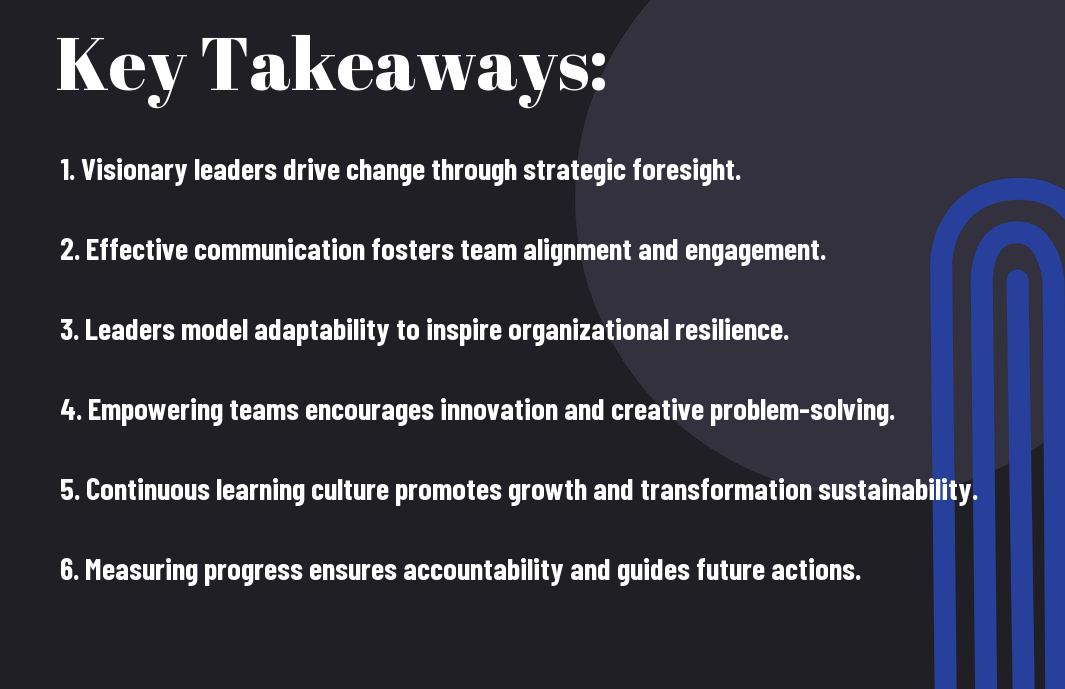
Most successful business transformations rely heavily on effective leadership. As you navigate through organizational change, understanding your role as a leader becomes paramount. Your ability to inspire, communicate vision, and engage your team can significantly influence the transformation process. This blog post will explore how strong leadership can steer your business through the complexities of change, fostering an environment that embraces innovation and growth. You’ll discover key strategies to enhance your leadership approach and drive meaningful transformation in your organization.

Understanding Business Transformation
To navigate today’s rapidly evolving market landscape, understanding business transformation becomes important. It involves rethinking and reshaping your organization’s operations, culture, and strategies to adapt to new challenges and opportunities. By embracing transformation, you position your organization to thrive in a competitive environment, fostering growth and innovation.
Definition and Importance
At its core, business transformation refers to a comprehensive and strategic overhaul of your organization. It’s important because it enables you to respond effectively to market demands, technological advancements, and customer expectations. This responsiveness not only enhances operational efficiency but also strengthens your overall business model and value proposition.
Key Drivers of Transformation
On the path to transformation, several key drivers propel your organization forward. These include technological advancements, shifting customer preferences, competitive pressures, and regulatory changes. Each of these factors compels you to adapt your strategies and processes, ensuring your business remains relevant and responsive in an ever-changing environment.
But understanding these drivers is just the beginning. You must analyze how these elements interact with your organization, recognizing that they are not static but continuously evolving. For example, emerging technologies can reshape customer behaviors while changing regulations may necessitate a strategic pivot. By staying attuned to these dynamics, you can effectively steer your business transformation, ensuring sustainability and success in the long run.
Leadership Characteristics for Successful Transformation
Now, to navigate the complexities of business transformation, leaders must embody specific characteristics that foster resilience, adaptability, and engagement within their teams. These traits empower you to inspire others and guide your organization effectively through change, ensuring that both strategy and execution align seamlessly with your vision for the future.
Visionary Leadership
Transformation requires a clear and compelling vision. As a leader, you must communicate your organization’s aspirations effectively, engaging your team in a shared purpose. A strong vision not only motivates but also provides a roadmap, helping everyone understand their role in achieving collective goals.
Emotional Intelligence
The impact of emotional intelligence on leadership is significant. You must cultivate an awareness of your own emotions as well as those of your team members, as this understanding fosters a collaborative and supportive environment. Emotional intelligence enables you to navigate interpersonal relationships judiciously, creating a culture where trust and open communication thrive.
Emotional intelligence comprises self-awareness, self-regulation, motivation, empathy, and social skills. By honing these attributes, you can enhance your ability to connect genuinely with others, facilitating smoother transitions during transformation. This connection not only promotes buy-in from your team but also helps mitigate resistance to change, fostering an environment where innovation and collaboration flourish.
The Role of Communication in Leadership
Once again, effective communication stands at the forefront of impactful leadership during business transformation. As a leader, your ability to convey the vision, goals, and changes within the organization can significantly influence employee engagement and morale. When you share information transparently and consistently, you foster a culture of trust and collaboration, enabling your team to align with the transformation process and navigate challenges with confidence.
Transparency and Trust
The foundation of successful leadership lies in your commitment to transparency. By openly sharing the rationale behind decisions and changes, you build trust among your team. This transparency allows employees to feel valued and informed, creating an environment where they are more willing to embrace and support the transformation journey.
Engaging Stakeholders
Along the path of transformation, engaging stakeholders is necessary for fostering a sense of ownership and partnership. When you actively involve your stakeholders in the decision-making process, you not only gather valuable insights but also enhance their commitment to the success of the initiative.
Transparency in your communication with stakeholders enhances collaboration and encourages them to contribute their unique perspectives. By creating channels for feedback and dialogue, you ensure that everyone feels heard and acknowledged. This two-way interaction not only enriches the transformation strategy but also solidifies the support required for effective execution. Ultimately, when your stakeholders are engaged and informed, you pave the way for a smoother and more successful transformation process.
Strategic Decision-Making in Transformation
Many organizations face the challenge of strategic decision-making during transformation initiatives. Your ability to make well-informed choices will significantly influence the success of the transformation process. Whether you are addressing market shifts or internal challenges, applying a structured approach to decision-making helps align your organization’s vision with its operational capabilities. Engaging stakeholders and utilizing data analytics will empower you to navigate complexities and achieve desired outcomes effectively.
Risk Management
Decision-making in the context of risk involves identifying potential threats and understanding their impact on your transformation efforts. You must evaluate both internal and external factors that could derail progress, ensuring that risks are mitigated through proactive strategies. Engaging your team in discussions about risk not only fosters a culture of transparency but also ensures that everyone is collectively invested in overcoming obstacles.
Resource Allocation
At the heart of effective transformation lies the art of resource allocation. You need to assess where to best direct financial, human, and technological resources to support your strategic objectives. Prioritizing initiatives based on their potential return on investment while maintaining flexibility will allow you to adapt as circumstances change.
Risk becomes a significant factor when you allocate resources for transformation. You must analyze potential pitfalls associated with varying levels of investment across different projects. Prioritizing the most beneficial initiatives while ensuring contingency plans are in place will enhance your organization’s resilience. Also, transparent communication regarding resource allocation fosters trust and collaboration, enabling team members to understand how their roles impact overall objectives. This clarity allows you to navigate uncertainties effectively, ensuring that your transformation journey remains on track.
Building a Culture of Innovation
After establishing a vision for change, you must prioritize building a culture of innovation within your organization. This involves creating an environment where new ideas are welcomed, risks are accepted, and learning from failure is encouraged. By fostering a cultural shift that values innovation, you empower your team to think beyond traditional boundaries and contribute more effectively to your business transformation efforts.
Fostering Team Collaboration
After laying the groundwork for innovation, focus on fostering team collaboration. Encourage open communication and diverse perspectives among your team members. When individuals feel comfortable sharing their thoughts and ideas, they are more likely to cooperate and develop creative solutions that drive your business forward.
Encouraging Creativity and Experimentation
Experimentation is key to developing a culture of innovation. You should actively encourage your team to explore new methods, test unorthodox ideas, and embrace the possibility of failure as a learning opportunity. This proactive approach allows for continuous growth and adaptation as your organization navigates the evolving business landscape.
Hence, to truly embed creativity within your team, provide them with the resources and support they need to experiment. This could include allocating time for brainstorming sessions, investing in training that fosters creative thinking, and celebrating unconventional ideas. By doing so, you create a dynamic atmosphere where innovation flourishes and your business can continuously adapt and thrive in a competitive market.
Measuring Leadership Impact on Transformation
Despite the complexities surrounding business transformation, assessing leadership’s impact is vital. Effective leadership not only guides teams through change but also drives measurable results. You must focus on aligning your leadership objectives with the overall transformation goals. This alignment allows you to evaluate how leadership behaviors influence employee engagement, operational efficiency, and ultimately, the success of change initiatives.
Performance Metrics
At the heart of measuring leadership impact are performance metrics that provide quantitative data on how leadership decisions affect transformation outcomes. You should consider metrics such as employee retention rates, productivity levels, and project completion times to gain insights into your leadership effectiveness during transformation efforts.
Feedback Mechanisms
Alongside performance metrics, implementing feedback mechanisms helps you capture qualitative data on leadership effectiveness. Regular feedback from your team allows you to gauge their perceptions of your leadership style, communication, and overall influence on the transformation process.
In fact, establishing a culture of open feedback enables continuous improvement in your leadership approach. By soliciting input from employees through surveys, one-on-one discussions, or team meetings, you gain valuable insights that can inform your leadership strategies. This ongoing dialogue not only fosters trust but also encourages adaptability, ensuring that you can pivot your approach based on real-time feedback during the transformation journey.
Final Words
To wrap up, your role as a leader in business transformation is pivotal. You set the vision and foster a culture that embraces change, empowering your team to innovate and adapt. By communicating effectively and modeling resilience, you guide your organization through challenges and ensure that your transformation efforts align with strategic goals. Ultimately, your leadership not only drives the success of the transformation but also cultivates a sustainable environment where continuous improvement thrives.
Leave a Reply